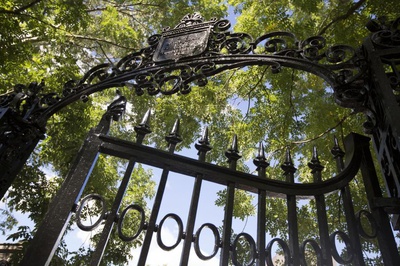
News
News Flash: Memory Shop and Anime Zakka to Open in Harvard Square

News
Harvard Researchers Develop AI-Driven Framework To Study Social Interactions, A Step Forward for Autism Research

News
Harvard Innovation Labs Announces 25 President’s Innovation Challenge Finalists

News
Graduate Student Council To Vote on Meeting Attendance Policy

News
Pop Hits and Politics: At Yardfest, Students Dance to Bedingfield and a Student Band Condemns Trump
Harvard Researcher Among Group Developing Material for Light-Based Computing

A team of researchers from Harvard’s School of Engineering and Applied Sciences, McMaster University, and University of Pittsburgh discovered a new material that can exhibit chemical and mechanical responses to light — paving the way for computing to be executed with only beams of light rather than hard materials.
At the heart of the team’s work is a unique type of hydrogel, according to a recent paper the team published in Proceedings of the National Academy of Sciences. Hydrogels are non-linear optical materials, a class of materials that change when they interact with light.
Interaction with light alters how the light propagates through the material, according to SEAS graduate student Amos Meeks, a co-author of the paper.
Anna C. Balazs, a professor of engineering at the University of Pittsburgh and another co-author of the study, said the hydrogel’s exposure to light or heat triggers a chemical reaction that causes the material to shrink. The collapse of material condenses the polymer and forces the light to become highly localized, rather than dispersed. When the light disappears, the hydrogel is able to return to its original state.
The unique feature of the group’s newly created hydrogel is its ability to couple several different responses at once, particularly the response to a light stimulus that ultimately causes the material to contract and alter the dispersion of light, according to Balazs.
“The optics is talking to the chemistry, which is talking to mechanical response, which in turn feeds back on the optics,” Balazs said. “Creating those kinds of feedback loops is very novel.”
Balazs said that the idea of a feedback loop could pave the way for the creation of materials with new features in the future.
“The integration of acting on different responses to give you one performance is stunning, and that’s the real advance here,” Balazs said. “What it really allows you to do is create materials that can maintain their state and are self-regulating. In response to a stimulus they can modulate their internal properties so they can deal with that stimulus.”
Kalaichelvi Saravanamuttu, an associate professor of Chemistry and Chemical Biology at McMaster and a co-author of the study, noted that the findings also contribute towards an emerging field called “materials that compute” — soft constructs that are responsive and designed with local computational ability.
“The paper presents a creative platform to generate soft adaptive constructs that could perform computational operations with visible light beams - without the need for external processors or electronic components” Saravanamuttu wrote in an emailed statement.
She added that the team’s work is distinct from other optical computing approaches.
“It is important to make a distinction between this work and other approaches to optical computing that examine ways to replace electronic functions in a digital computer with photon-based counterparts.”
Meeks said there are still many questions that need to be answered before this type of material could be applied or put to use.
“This is kind of the first demonstration of this phenomenon at all in these types of materials,” he said. “There’s a lot of questions that would still need to be answered before there’s any kind of application.”
—Staff writer Brie K. Buchanan can be reached at brie.buchanan@thecrimson.com.
Want to keep up with breaking news? Subscribe to our email newsletter.
From Our Advertisers

Over 300+ courses at prestigious colleges and universities in the US and UK are at your disposal.

Where you should have gotten your protein since 1998.

Serve as a proctor for Harvard Summer School (HSS) students, either in the Secondary School Program (SSP), General Program (GP), or Pre-College Program.

With an increasingly competitive Law School admissions process, it's important to understand what makes an applicant stand out.

Welcome to your one-stop gifting destination for men and women—it's like your neighborhood holiday shop, but way cooler.

HUSL seeks to create and empower a community of students who are seeking pathways into the Sports Business Industry.
